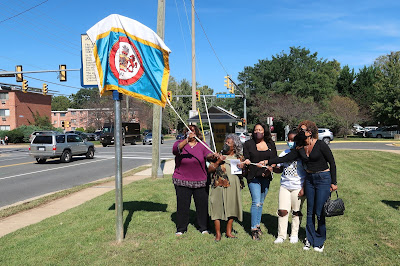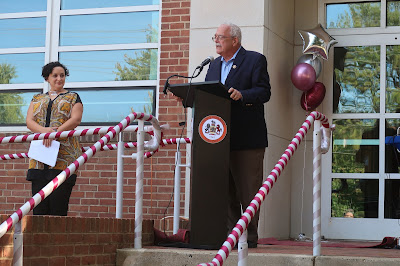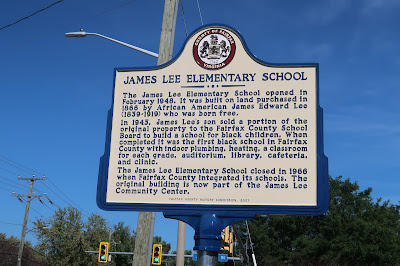New historic marker commemorates James Lee Elementary School
 |
| Descendants of James Lee pull the cord to unveil a historic marker commemorating James Lee Elementary School. |
Alma Amaker, who attended James Lee Elementary School when it opened in 1948 in Falls Church, remembers it as the “very best concept of a neighborhood school.”
Amaker spoke at the unveiling of a historic marker Oct. 2 commemorating James Lee as the first modern school for Blacks in Fairfax County.
 |
| Former students at James Lee Elementary School Alma Amaker (left) and JoAnn Brooks. |
The marker, on Annandale Road, is in front of what is now the James Lee Community Center, which incorporates part of the original school building.
James Lee Elementary School was built on land purchased in 1866 by Edward Lee, an African American who had never been enslaved.
In 1945, James Lee’s son sold a portion of the property to the Fairfax County School Board to build a school for Black children. When completed, it was the first Black school in the county with indoor plumbing, heating, a classroom for each grade, an auditorium, library, cafeteria, and clinic.
 |
| James Lee Elementary School in 1958. [FCPS] |
Before the James Lee School was built, Amaker attended a tiny school for Blacks in a dilapidated building with an old potbelly stove and hand-me-down textbooks.
One day, her teacher, Miss Julie, walked the kids to the brand-new James Lee Elementary School, where “everything was new and shiny.” She was delighted to find new desks, new restrooms, and a library full of books.
In another big surprise for Amaker, the new school had a water fountain with “no signs that said colored or white.”
“James Lee was a haven for us all,” she said. “We felt safe. We felt valued. We felt loved.”
One of her teachers, Miss Nellie, inspired her to become a teacher. Amaker went on to teach in Fairfax County Public Schools for 50 years.
 |
| Rep. Gerry Connolly speaks in front of the old facade of James Lee Elementary School. Supervisor Dalia Palchik is on the left. |
James Lee Elementary School was closed in 1966 when Fairfax County Public Schools were desegregated.
JoAnn Brooks, who was in the last class to graduate, shared happy memories of the school, including the annual May Day celebration when the kids unwrapped the ribbons around a Maypole. She also recalled the large rulers teachers used on students “who did something wrong.”
“James Lee will always have a special place in my heart,” Brooks said.
Several descendants of James Lee also attended the historic marker ceremony, along with elected leaders, county officials, Black history advocates, and members of the community.
Related story: Fairfax County forced Black families to vacate land for Justice Park
Rep. Gerry Connolly told the audience he once met a woman who lived near the James Lee school and remembered being bused to the only Black high school in the area, in Manassas. On the long bus ride, she passed many White students walking to schools she was not allowed to attend.
Connolly said he expects the county will take down or revise other historic markers that honor Confederates or slaveholders.
He also called for the school board to rename Woodson High School. That school is named for Wilbert Tucker Woodson, who chaired the school board from 1929 to 1961 and opposed the immediate desegregation of public education in defiance of the Supreme Court’s 1954 ruling in Brown v. Board of Education.
Dalia Palchik, a member of the Board of Supervisors representing the Providence District, announced a historic marker contest to be launched in January, calling for students to suggest more historic markers on Black history.
The new markers would focus on narratives and oral history about people and events underrepresented in history books, Palchik said.
Historic markers are important, said Karla Bruce, Fairfax County’s chief equity officer, because “you’re making sure your history will be told.”



What a wonderful story! What remains in my thoughts, however, is that this area of Fairfax County used to be a part of the town of Falls Church. When the town incorporated as a city in the 1940s, it carved out of itself that part of the community that was primarily Black.
My daughter was in Ms Alma Amaker’s English class 1996-97. She was a fabulous and dedicated teacher. She taught English and many life lessons. If you didn’t do your homework, you stayed in her class during lunch. My daughter lived her and her class. She taught To Kill A Mockingbird and told the students about growing up in Jim Crow Virginia. Truly a leader who raised a beautiful son.